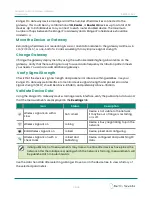
Open the Device
Before opening the device, de-energise the cables and remove the device from the field
and operating environment. Open the casing by loosening and partially removing the
captive screws on one of the hinges and completely removing the captive screws on
the other hinge.
Clean the Interior
Clean the interior using a clean, dry, anti-static cloth.
Inspect the Device Casing
The device casing is made of anodised Aluminum and is epoxy-powder coated. Inspect the:
l
Aluminum device casing for damage or oxidation.
l
Lithium battery and terminal springs. Look for chemical corrosion or deposits.
l
Antenna N-Type connector for soiling or oxidation.
l
Power M12 and network RJ45 connectors for soiling or damage to the seals.
Inspect the Lid Seal
The device uses a continuous seal to protect the unit against dust and moisture ingress. The seal
maintains the device’s dust and water-resistant IP rating.
Inspect the seal:
l
Verify that the seal is free from dust and debris.
l
To remove dust and dirt, use a clean, dry cloth.
Inspect the Battery
Inspect the battery before removing it. Look for:
l
Swelling or deformation.
l
Indentations or lifting of battery terminals.
l
Moisture or liquid on the battery surface.
l
Chemical corrosion or deposits on the battery terminals.
CAUTION
EQUIPMENT DAMAGE
Do not use a device with a damaged enclosure or Lithium
battery. Using a damaged device may further damage the
device, cause it to fail, or in hazardous locations cause other
unintended consequences.
If a battery has leaked, do not touch the corrosive electrolyte.
42/46
Ranger Pro ISA100 Wireless Gateway
User Guide
158M1430 Rev. -





































